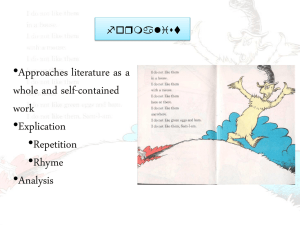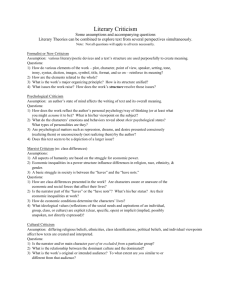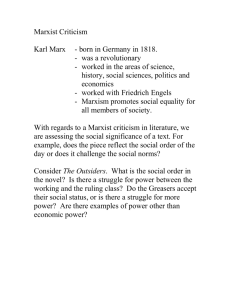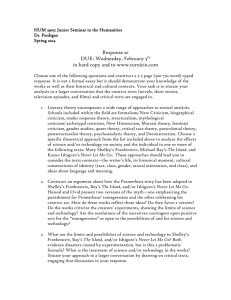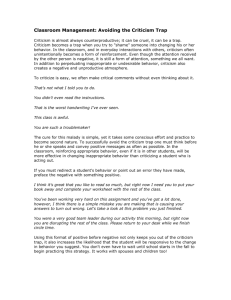Media content
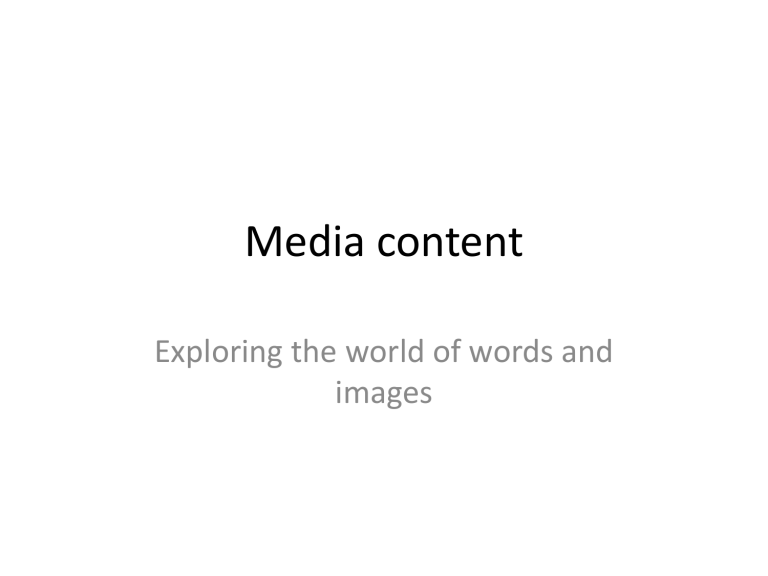
Media content
Exploring the world of words and images
Content
• Symbolic and iconic representation of ideas
– “Ideation” may be dependent upon the learning of a system of representation (reciprocal influence)
– In any culture, a ‘language’ develops somewhat arbitrarily in order that members of the culture can create and share meaning
• “signification”
Semiotics
• Considered by Ferdinand de Saussure and
Charles Sanders Peirce as the scientific analysis of symbol systems
– Languages are a very large part, but not all, of cultural symbol systems
Semiotics
• All languages, icons, pictures, gestures, etc. belong to a system of representation
• All such systems exhibit rules, relations among their parts, etc.
– Structure
• Relations among the parts of such a system, and between the system and the ‘reality’ it both reflects and constitutes provide the basis for semiology and related areas of scholarly inquiry
Studying ‘content’
• No ‘neutral’ presentation exists—even a photograph reflects the choice of camera lens, film stock, f-stop, angle toward subject, framing, choice of subject, and many other often “unconscious” decisions
• Language use in news stories
• Narrative voice in commercials
Studying content
• Content can be said to include all relatively fixed representations
• Available for analysis in ways that more instantaneous and transitory phenomena are not
• Scholarly study can reveal features, relationships, emphases, etc. that are not at first obvious to producers or consumers of content
“Bias”
• The question is not whether bias exists, but which biases dominate
• No ‘objective’ or ‘unbiased’ representation exists or could be possible—all representations must make choices of emphasis, word use, construction, etc.
– Critical theory usually seeks to relate representational biases to social power
– “Hidden” biases—ideology, framing, etc.
• Benevolent racism
• Colonialist attitudes
• “Triumph of capitalism”
• Individual freedom and market capitalism
Significant considerations for study
• The nature of representations of ‘real’ phenomena and how they relate to the ‘true nature’ of those phenomena
• The underlying structures of representations
• The interaction of the content and audience sense-making
• Influences on the production of texts and how these are reflected in artifacts
• Cultural presumptions/beliefs embedded in texts
– Race, religion, gender, politics, deviance
• Relations of depictions and audience pleasure
• Professional standards and rules, and their incorporation in texts
• Topics chosen and avoided
• Rhetorical devices and ‘slanting’ of content
Content analysis
• The traditional form of social science approach to the analysis of content (“texts” or
“artifacts”) is to develop a set of categories based on theory and score chunks of content based on the scheme
• Gerbner and associates’ approach to studying violence and other tendencies in televised content
Quantitative content analysis
• Note: The number of occurrences or other quantitative marker is taken as an indicator of emphasis or importance
– Criticized by qualitative researchers
• Requires some form of categorization scheme
prior to analyzing the artifacts
– Significantly limits what can be studied
Value of content analysis
• Sets a verifiable standard
• The quantitative occurrence of markers within artifacts seems like a reasonable indicator of importance for a number of significant concepts
– Lack of Latino characters in lead roles as an indicator of ‘invisibility’
– Percentage of protagonists who defeat antagonists
– Positive descriptions of Democrats, negative of
Republicans (or vice versa)
Value of content analysis
• Allows for external “checking” of theory and research
– Collaborative scientific enterprise
• Forces systematic explication from theory to method and interpretation of results
• Prediction limits idiosyncratic interpretations
Problems with content analysis
• Many scholars argue that chopping a text/story, etc. into bits undermines our ability to understand its meaning
– Single examples of violence taken out of story context cannot be understood as an audience member would
• The number of times some action or statement or depiction occurs may not be a good indicator of its importance
– Some scenes, actions, etc. occur rarely but are crucial to the meaning conveyed
Problems with content analysis
• Content analyses are often unable to unearth the connotative meanings underlying many stories, presentations, etc.
– Difficult to identify metaphor, fantasy theme, etc.
– Accept rather than challenge current conditions, at least as a starting point
• Critical theorists use research with the explicit goal of challenging current conditions in order to improve the lives of a disadvantaged group
Qualitative text analyses
• Qualitative study of texts are less concerned with the number of times particular items, ideas, etc. can be found in artifacts and more concerned with attempting to draw out the cultural
‘meaning’ of the artifact
• They usually involve some sort of ‘deep reading’ of an artifact by a scholar well-versed in the theoretical domain
– Because meaning is not obvious, the ‘reader’ must be steeped in the theory or theories brought to bear in order to effectively identify what is going on in the text
Sonja Foss: Rhetorical Criticism: Exploration
and Practice, Fourth Edition
• Part I. INTRODUCTION
1. The Nature of Rhetorical Criticism
2. Doing Rhetorical Criticism
3. Neo-Aristotelian Criticism
Part II. CRITICAL APPROACHES
4. Cluster Criticism
5. Fantasy-Theme Criticism
6. Feminist Criticism
7. Generic Criticism
8. Ideological Criticism
9. Metaphoric Criticism
10. Narrative Criticism
11. Pentadic Criticism
12. Generative Criticism
Reading the Romance
• What qualitative and what quantitative elements does Radway’s analysis of the romance novel employ?
• How does the analysis help to bring underlying cultural tendencies to light?
• What can we say of the ‘meaning’ of the texts?
Cultural analyses
• Narrative construction
– How are stories ordered, constructed, changed?
– What kinds of characters exist and what are their functions? What do they represent?
– Who is the narrator? Why does it matter?
– What ‘realities’ are portrayed?
• What is “Middle Earth” anyway?
• Realism—the dominant mode of Western representation
Value of qualitative text analyses
• Deeper, more nuanced analysis of artifacts and their ‘meaning’ within a culture
– Encourages analyses that focus on deep meaning—connotations and myths, “Unexamined presuppositions”
• Allows for discovery during the research process
– Less dependence upon category scheme developed without exposure to artifact
Problems
• Requires a ‘worldview’ or overarching theoretical understanding to carry out such an analysis
– Contrary to some statements, meaning does not
‘emerge’ from data
– Means that trying to ‘train coders’ is unlikely to be effective
Problems
• Interpretations are not easily evaluated according to traditional methods
– There is no ‘reliability’ in a statistical sense
– Checking with the ‘authors’ of the artifacts is unlikely to be considered adequate
• Unintended meanings are often considered the most important
• Readings will deviate significantly from authors’ intent
Problems
• The worst case scenario, and one that is quite common, is an idiosyncratic reading of an artifact that must depend for its acceptance by the scholarly community upon the eloquence of the researcher rather than evidence seen as ‘scientifically valid’
Important concerns
• Are you interested in an in-depth analysis of a single artifact or identification of general tendencies across a large number of artifacts?
– Freudian analysis of “Rear Window” or auteur analysis of
Hitchcock films?
• Are you trying to link the content to structures/ influences over production, or to audience effects?
– E.g., correlating political coverage with newspaper chain ownership
• Or are you studying the structure of cultural artifacts as an end in themselves?
– Scholarly criticism of a television series
